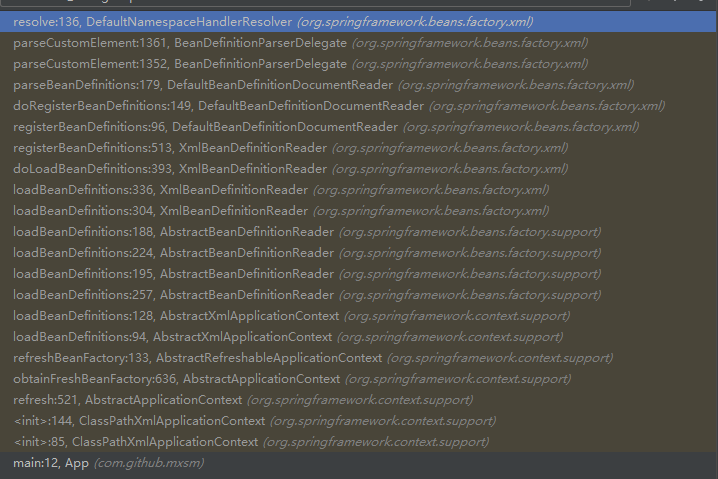Spring如何解析自定义xml的源码解析
1. Spring如何加载自定义的xml Element
下面来通过代码的Debug来看Spring是如何加载自定义的xml Element
代码:https://github.com/mxsm/spring-sample/tree/master/namespace-handler
2. NamespaceHandler的继承关系
首先看一下 NamespaceHandler 的继承关系

从上图可以看出来几个比较熟悉的:
-
AopNamespaceHandler
aop 的 Element 处理
-
TxNamespaceHandler
事务的处理节点
在继承过程中抽象类 NamespaceHandlerSupport 实现了 NamespaceHandler 。自定义也是主要通过 NamespaceHandlerSupport 实现这个抽象类。
3. 如何加载使用NamespaceHandler的实现类
在 Spring 中定义了一个 NamespaceHandlerResolver 接口用来解析 NamespaceHandler
@FunctionalInterface
public interface NamespaceHandlerResolver {
/**
* Resolve the namespace URI and return the located {@link NamespaceHandler}
* implementation.
* @param namespaceUri the relevant namespace URI
* @return the located {@link NamespaceHandler} (may be {@code null})
*/
@Nullable
NamespaceHandler resolve(String namespaceUri);
}
这个接口就一个人方法,方法的参数传入的是命名空间的Uri。在 Spring中实现了这个接口的只有一个类 DefaultNamespaceHandlerResolver 。下面一下这类的代码实现(主要关注一下resolve方法):
public class DefaultNamespaceHandlerResolver implements NamespaceHandlerResolver {
/**
* 空间URI和处理器对应关系存放的文件(自定义同样会被加载)
*/
public static final String DEFAULT_HANDLER_MAPPINGS_LOCATION = "META-INF/spring.handlers";
/** Logger available to subclasses. */
protected final Log logger = LogFactory.getLog(getClass());
/** ClassLoader to use for NamespaceHandler classes. */
@Nullable
private final ClassLoader classLoader;
/** Resource location to search for. */
private final String handlerMappingsLocation;
/** Stores the mappings from namespace URI to NamespaceHandler class name / instance. */
@Nullable
private volatile Map<String, Object> handlerMappings;
/**
* Create a new {@code DefaultNamespaceHandlerResolver} using the
* default mapping file location.
* <p>This constructor will result in the thread context ClassLoader being used
* to load resources.
* @see #DEFAULT_HANDLER_MAPPINGS_LOCATION
*/
public DefaultNamespaceHandlerResolver() {
this(null, DEFAULT_HANDLER_MAPPINGS_LOCATION);
}
/**
* Create a new {@code DefaultNamespaceHandlerResolver} using the
* default mapping file location.
* @param classLoader the {@link ClassLoader} instance used to load mapping resources
* (may be {@code null}, in which case the thread context ClassLoader will be used)
* @see #DEFAULT_HANDLER_MAPPINGS_LOCATION
*/
public DefaultNamespaceHandlerResolver(@Nullable ClassLoader classLoader) {
this(classLoader, DEFAULT_HANDLER_MAPPINGS_LOCATION);
}
public DefaultNamespaceHandlerResolver(@Nullable ClassLoader classLoader, String handlerMappingsLocation) {
Assert.notNull(handlerMappingsLocation, "Handler mappings location must not be null");
this.classLoader = (classLoader != null ? classLoader : ClassUtils.getDefaultClassLoader());
this.handlerMappingsLocation = handlerMappingsLocation;
}
/**
* 解析传入的命名空间的URI
*/
@Override
@Nullable
public NamespaceHandler resolve(String namespaceUri) {
Map<String, Object> handlerMappings = getHandlerMappings();
Object handlerOrClassName = handlerMappings.get(namespaceUri);
if (handlerOrClassName == null) {
return null;
}
else if (handlerOrClassName instanceof NamespaceHandler) {
return (NamespaceHandler) handlerOrClassName;
}
else {
String className = (String) handlerOrClassName;
try {
Class<?> handlerClass = ClassUtils.forName(className, this.classLoader);
if (!NamespaceHandler.class.isAssignableFrom(handlerClass)) {
throw new FatalBeanException("Class [" + className + "] for namespace [" + namespaceUri +
"] does not implement the [" + NamespaceHandler.class.getName() + "] interface");
}
NamespaceHandler namespaceHandler = (NamespaceHandler) BeanUtils.instantiateClass(handlerClass);
//调用init方法--所以在实现 NamespaceHandlerSupport只需要
//实现init方法原因就在这里
namespaceHandler.init();
handlerMappings.put(namespaceUri, namespaceHandler);
return namespaceHandler;
}
catch (ClassNotFoundException ex) {
throw new FatalBeanException("Could not find NamespaceHandler class [" + className +
"] for namespace [" + namespaceUri + "]", ex);
}
catch (LinkageError err) {
throw new FatalBeanException("Unresolvable class definition for NamespaceHandler class [" +
className + "] for namespace [" + namespaceUri + "]", err);
}
}
}
/**
* 获取META-INF/spring.handlers里面的对应的命名空间URI和空间处理器的
* 对应的关系
*/
private Map<String, Object> getHandlerMappings() {
Map<String, Object> handlerMappings = this.handlerMappings;
if (handlerMappings == null) {
synchronized (this) {
handlerMappings = this.handlerMappings;
if (handlerMappings == null) {
if (logger.isTraceEnabled()) {
logger.trace("Loading NamespaceHandler mappings from [" + this.handlerMappingsLocation + "]");
}
try {
Properties mappings =
PropertiesLoaderUtils.loadAllProperties(this.handlerMappingsLocation, this.classLoader);
if (logger.isTraceEnabled()) {
logger.trace("Loaded NamespaceHandler mappings: " + mappings);
}
handlerMappings = new ConcurrentHashMap<>(mappings.size());
CollectionUtils.mergePropertiesIntoMap(mappings, handlerMappings);
this.handlerMappings = handlerMappings;
}
catch (IOException ex) {
throw new IllegalStateException(
"Unable to load NamespaceHandler mappings from location [" + this.handlerMappingsLocation + "]", ex);
}
}
}
}
return handlerMappings;
}
@Override
public String toString() {
return "NamespaceHandlerResolver using mappings " + getHandlerMappings();
}
}
通过断点的方式来看一下整个调用方法的调用如下图:

下面来分一下整个调用链的过程,上面断点打在 DefaultNamespaceHandlerResolver 的 resolve 方法的下面这段代码处
handlerMappings.put(namespaceUri, namespaceHandler);
细心的话可能你会发现debug的过程中,如果你xml中包含 bean这个节点你会发现并不会走到你的断点这个地方来这个是为什么呢?(答案会在下面的分析过程中给出来)
Debug的代码在上面已经给出来了。
在调用过程中有一个 DefaultBeanDefinitionDocumentReader 类。通过上图可以看出调用了这样一段方法
protected void parseBeanDefinitions(Element root, BeanDefinitionParserDelegate delegate) {
//判断是否为http://www.springframework.org/schema/beans默认的空间
if (delegate.isDefaultNamespace(root)) {
NodeList nl = root.getChildNodes();
for (int i = 0; i < nl.getLength(); i++) {
Node node = nl.item(i);
if (node instanceof Element) {
Element ele = (Element) node;
//判断是否为默认的命名空间
if (delegate.isDefaultNamespace(ele)) {
parseDefaultElement(ele, delegate);
}
else {
//自定义的命名空间--用户自定义的和Spring AOP等等
delegate.parseCustomElement(ele);
}
}
}
}
else {
delegate.parseCustomElement(root);
}
}
上面的方法给出了为什么没有进入 DefaultNamespaceHandlerResolver 中,因为只有http://www.springframework.org/schema/bean才是默认的命名空间